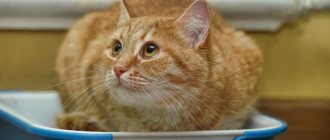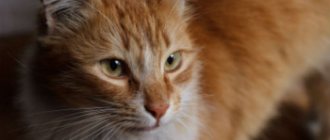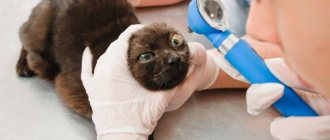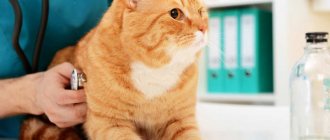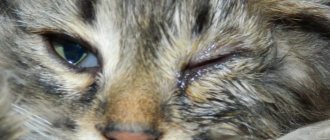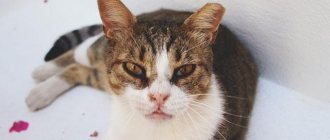Feelings of fear and anxiety can affect cats in the same way that these feelings affect us. Stress can occur in your cat for several reasons. Perhaps you've recently moved or have a new pet or family member in your home. Be that as it may, stress often causes health problems in your pet. One of the first symptoms of stress-induced urinary tract disease is the cat's refusal to use the litter box. At the same time, she may begin to urinate in a new, “wrong” place or on the walls, or she may experience difficulty, most often caused by pain, when urinating.
Unfortunately, urinary problems are one of the most common reasons why cats are abandoned in shelters or even euthanized or thrown into the streets. If a cat begins to urinate outside of its litter box, it is not doing so out of revenge or anger. There's probably something wrong with her. It could also be a behavioral problem, for example, she may not like her litter box for some reason, but health problems should be ruled out first. One of the most common causes of urinary dysfunction is feline lower urinary tract disease (FLUTD) or feline urological syndrome.
Symptoms of cystitis in cats
Cystitis in cats leads to difficult, painful urination (pollakiuria, stranguria). This condition can be accompanied by various symptoms:
- a sick cat often and for a long time visits the tray, leaving only small puddles or even drops of urine in it;
- restless behavior;
- obsessive states - for example, the cat often licks under the tail, does not allow touching the stomach;
- lethargy;
- decreased appetite;
- in acute cases, blood may appear in the urine.
Sometimes cystitis is perceived as incontinence - the owner sees that wherever the cat sat or lay, small puddles of urine remain. Urination may be accompanied by vocalization - meowing, and other sounds that the cat makes due to painful sensations.
Cats suffering from cystitis may decide that the pain when urinating is associated with the litter box - and then the owner’s bed, slippers, and upholstered furniture suffer. Therefore, any violation of the toilet behavior of a cat, especially an adult one that has not previously failed with the litter box, is a reason to consult a doctor. Owners often think that a cat that urinates in the wrong place is “revenge” for something, or is simply poorly educated - in fact, in most cases the problem is not related to behavior, but to cystitis. Therefore, before punishing a cat that went to the toilet in the wrong place, show it to the veterinarian.
Maintenance and feeding during treatment
To restore strength and speed up the treatment of cystitis, the cat needs to create a calm home environment. Rest, adequate sleep, lack of stress, and abstinence from active games with your pet contribute to a faster recovery. The cat cannot be taken to exhibitions or for mating for up to three months after complete recovery. During therapy, the pet should be in a warm room without drafts. The ideal mat for a cat is a warm bed with high walls.
When going to the veterinary clinic and for the first time of treatment for cystitis with uncontrollable urges, it is recommended to put a diaper on the cat. This attribute changes as it is filled. Typically, two diapers per day are enough for an adult. For cats weighing from 2 to 4 kg with a belly girth of less than 35 cm, size S diapers are suitable. For larger cats - weighing up to 7 kg and a belly girth of up to 48 cm, size M is needed.
global $ads_google; //data-ad-slot=”2475549904″ $ads_google = empty($ads_google) ? false : true; ?> if ($ads_google == false) {?> $ads_google = true; ?> } ?>
The animal should always have clean drinking water within its reach. Drinking plenty of fluids helps reduce urine concentration and actively eliminate toxins and drug half-lives. If the analysis shows acidification of the urine, then baking soda (sodium bicarbonate) must be added to the drinking water. For 1 liter of liquid, 5-7.5 g of powder is enough. When alkalizing urine, a decoction of bearberry leaves has a good effect.
Suitable feed
A balanced, nutritious diet provides the cat’s body with the entire complex of nutrients and biologically active substances. For a weakened animal, it is necessary to choose premium dry and wet food or special formulations intended for cats with diseases of the excretory system.
The formulation of veterinary feeds is developed taking into account the needs of the sick organism. They contain easily digestible substances with the required acidity. This diet prevents the formation of urinary stones and helps dissolve existing solids. The amount of minerals in specialized feeds is reduced. This makes the urine less concentrated. Ready-made food for cats has a slight diuretic effect, which promotes better removal of toxic substances.
global $ads_google; //data-ad-slot=”2475549904″ $ads_google = empty($ads_google) ? false : true; ?> if ($ads_google == false) {?> $ads_google = true; ?> } ?>
For diseases of the distal excretory system, experts recommend food from the Urinary Feline or Urinary Care category. They are found in well-known cat food brands Royal Canin and Hill's. This therapeutic dietary food is not suitable for all pets, as it has restrictions on its use. The list of contraindications includes pregnancy, lactation, chronic heart and kidney failure, hypertension, acidifying therapy.
If the menu is made up of natural food, then milk, meat broths, and cereals are chosen for feeding. The diet should consist of easily digestible and non-irritating foods. Fatty ingredients that create increased stress on the digestive and excretory organs are excluded.
Causes of cystitis
Cystitis can be caused by:
- damage to the mucous membrane by salt crystals or larger stones (stones) in urolithiasis in cats;
- changes in the bladder wall due to tumor or injury;
- penetration of pathogenic bacteria and viruses;
- unbalanced feeding;
- insufficient water consumption;
- intoxication;
- Without obvious reasons - idiopathic cystitis.
It is important to establish the cause of the disease - treatment tactics depend on it.
The most common is idiopathic cystitis, this is due to the peculiarities of water metabolism in cats. Very often, cystitis is observed in conjunction with urolithiasis; it is reliably difficult to say what was the root cause - bacteria in the bladder that cause inflammation can serve as centers of crystallization and thus contribute to the formation of stones, and crystals and stones, in turn, can injure the walls of the bladder and provoke the development of cystitis.
Separately, it is necessary to say about feeding habits that can provoke the development of cystitis. Contrary to popular belief, dry food does not lead to cystitis and urolithiasis in cats. But it does have an indirect effect - some cats on diets with dry food do not drink enough water due to the peculiarities of their water metabolism. As a result, the urine is very highly concentrated, dense, and such urine serves as a very good environment both for the development of bacteria and for the precipitation of salts, which can turn into uroliths. This problem can be prevented by monitoring your cat's water intake. To understand whether your cat drinks enough water, you can take a general clinical urine test - if the density is high, then there should be more water. You can also observe the condition of the urine - dark, cloudy, with a pungent odor almost certainly requires dilution; the urine should be light and transparent. To increase water consumption, you can try several options - place bowls in different rooms of the house, use not only ordinary bowls, but also drinking fountains - some cats ignore standing water, but happily drink current water. You can add a few drops (for flavor) of milk or broth to the water, but such water must be changed frequently. Another way is to replace dry food with wet food, or have a nutritionist calculate your home diet.
An unbalanced home diet can also cause the development of cystitis in cats.
Read also
Urolithiasis in cats
Urolithiasis is a disease accompanied by the formation and deposition of urinary stones or sand
Castration of cats: pros and cons
Castration is the removal of the male gonads (testes in males, ovaries or ovaries and uterus in females)
Ear mites in cats: signs and treatment
The appearance of a parasite such as ear mites in a cat is the beginning of a serious disease that must be eradicated at the first symptoms.
Worms in cats: symptoms, signs and treatment
The first signs of infection may be absent for some time or resemble manifestations of other diseases
Sterilizing a cat: at home or in the clinic?
Sterilization is an intervention as a result of which an animal (a cat in particular) loses its ability to reproduce
Diagnosis of cystitis in cats
To make a diagnosis and develop a treatment plan, a number of examinations and tests are required; usually, a diagnosis of cystitis can be made based on anamnesis, clinical signs, ultrasound of the bladder and clinical urine analysis.
It may also be necessary to:
- Ultrasound examination of the abdominal cavity in a cat,
- clinical urine test,
- general clinical blood test,
- biochemical urine analysis.
In some cases, a bacteriological examination of urine (tank culture) is carried out - for this, a urine sample is taken into a sterile tube with a catheter or by puncturing the abdominal wall (cystocentesis). Other methods of collecting urine are not suitable, since many bacteria live on the surface of the skin and genitourinary organs, and the result will be unreliable. This analysis reveals the sensitivity of pathogenic bacteria to various antibiotics. This will allow you to accurately select an antibiotic for treatment, which is most important for chronic, difficult-to-treat cystitis in cats.
Sometimes a biopsy of the bladder wall is used to establish a definitive diagnosis.
Medicinal feed
A standard diet is not acceptable during therapy. Natural food should contain a minimum amount of fat and protein, but the norm is difficult to determine on your own. The task can be simplified by using a line of specialized high-class medicinal feeds. The composition contains the necessary list of components, vitamins, and a small amount of salt. There is a weak diuretic effect.
Using medicated food on a regular basis will help:
- reduce the amount of salts in the urine;
- increase the rate of primary urine formation per unit time;
- protect the liver from excess stress;
- normalize the flow of urine from the bladder.
The brand is selected by a veterinarian. Popular and trusted brands include Hill's, Royal Canin, Purina, Advance, etc. It is allowed to change feed when diagnosing urolithiasis. This will regulate the acidity of urine.
Switching your pet to a new food is extremely simple: you need to mix it into the old one, gradually increasing the amount. A sudden change can lead to an allergic reaction or gastrointestinal upset.
Idiopathic cystitis
If, based on the results of a complete examination, the cause of the development of cystitis is not established, the doctor may make a diagnosis of “idiopathic cystitis,” i.e. “having no apparent identifiable cause.” However, this disease is an independent entity in cats and is quite widespread in the population.
Stress can provoke the development of idiopathic cystitis in cats. It is believed that the predisposition to idiopathic cystitis is congenital, and is associated both with defects in the mucous membrane of the bladder and with increased production of “stress hormones” - catecholamines and cortisol.
Before and after tests
According to standards, treatment of cystitis with antibiotics is prescribed immediately. Before treatment, only a general urine test is required to detect signs of inflammation. And if it is not possible to take it to the laboratory, you can use an express test strip. Next, antibiotics are prescribed. In more than 80% of cases, cystitis is caused by the bacterium E. coli, or Escherichia coli. But opportunistic bacteria (Klebsiella, ureoplasma, streptococcus, staphylococcus) can also be causative agents. They themselves do not cause the disease, but weaken the body’s immune defense, and against this background pathological flora - fungi, bacteria - joins.
And after a course of antibacterial therapy, it is recommended to do a bacterial culture of the urine to make sure that there is no causative agent of the disease, which means that the infection has been cured.
Treating cystitis with folk remedies is less effective than antibiotics. Therefore, warm heating pads, herbs and cranberry juice are best used only in addition to treatment. And also only with the permission of a doctor, because any drugs, even herbal ones, can cause allergies or have individual intolerance. However, medicine knows cases of spontaneous healing of cystitis, when a strong immune system managed to cope with the inflammation on its own. However, playing “roulette” with a disease is quite dangerous, especially if there are effective medications.
How to treat cystitis in cats
Treatment of cystitis includes the use of painkillers (it is important to remove pain as a source of stress), antispasmodics, antimicrobials, diuretics (often herbal), and, if necessary, hemostatic drugs.
Self-treatment at home without the supervision of a doctor is strictly not recommended - the symptoms of cystitis are very similar to the symptoms of urolithiasis and a number of other, rarer pathologies, and treatment for these pathologies varies significantly. Sometimes owners begin to give their cats antibiotics on their own, based on human standards, information from the Internet, or the treatment of other animals - as a result, instead of bacteria, which with proper treatment could be eliminated once and for all, a microflora is obtained that is very resistant to cheap and accessible antibiotics, and permanent relapses, and treatment becomes much more expensive and lengthy. It can also be dangerous to use antispasmodics on your own - for example, no-spa, the most popular antispasmodic, which is often recommended on forums, can lead to fatal poisoning if overdosed in cats. With timely consultation with a doctor and proper diagnosis, treatment will take much less time and money, and your pet will avoid many complications.
If the cause of cystitis is large stones in the bladder (urolithiasis) or a neoplasm of the bladder wall (tumor or benign polyp), surgical treatment is indicated.
In each individual case, treatment will be prescribed by a doctor based on the cause of cystitis and the severity of the disease. The doctor makes a diagnosis and prescribes a treatment regimen; the rest of the treatment can take place at home, mainly by giving oral tablets and injections.
Video diagnosing cystitis in a cat:
Principles of treatment
It should be noted that the treatment of cats with cystitis is not much different from the therapeutic approaches of human medicine and can occur at home.
The most important point in treating a disease is the destruction of the pathogenic microorganism.
This is achieved with the help of antibacterial drugs - in this case they are taken: cephalosporins (ceftriaxone, cefoperazone) or fluoroquinolones (levofloxacin, ciprofloxacin). The recommended frequency of administration is twice a day with an interval of twelve hours (the recommended schedule is 8 am and 8 pm). The dosage is calculated purely individually, depending on the severity of the animal’s condition, age and body weight.
Ceftriaxone
Furagin
In addition, be sure to use uroseptics - they complement the action of antibacterial drugs, thereby potentiating the therapeutic effect. Furagin, furamag or furazolidone are used. Taken morning and evening, preferably before meals. You can use feed additives (“Stop-Cystitis”) to normalize and improve the functioning of the urinary system.
Don't forget about probiotics. Linex, Lactovit or yogurt are taken three times a day, otherwise the cat will have to be treated for dysbiosis.
It is strictly not recommended to treat an animal yourself at home without consulting a veterinarian and to use traditional medicine. Their effectiveness has not yet been proven, and in this case, delay could cost your pet his life.
Home care for cystitis in cats
In addition to drug therapy, it is necessary to choose a suitable diet for a sick cat, aimed at reducing urine concentration. For the same purpose, it is important to increase your cat's fluid intake. You can place bowls of clean water in several places, offer your cat a drinking fountain, try adding water to the food, or, as a last resort, force your pet to drink more. Sometimes a switch from dry food may be indicated (since cats may have an impaired sense of thirst, they may not drink enough water) to a wet or homemade diet (for cystitis, a veterinary nutritionist should prepare a homemade diet) so that the cat receives additional moisture from food.
Rest is very important for a sick cat. Stress both independently provokes the disease and aggravates cystitis caused by other reasons. Food, water and litter box should be in places where the cat will not be disturbed. You cannot scold or punish a sick cat if, in search of a “safe place,” it once again misses the tray. If there are several animals in the house, evaluate their relationships: it may be necessary to separate them from each other.
Cystitis in cats is an insidious disease that requires long-term treatment and is prone to relapse. Unfortunately, if a cat has had cystitis once, it may happen again after some time. Timely identification of the problem and proper treatment will prevent cystitis from becoming chronic.
(c) Veterinary center for the treatment and rehabilitation of animals “Zoostatus”. Varshavskoe highway, 125 building 1. tel. 8 (499) 372-27-37
How to care for an animal
During treatment, the animal must be isolated from drafts and not allowed to lie on the tiles. Heating the bedding is also not recommended. There are a number of other useful recommendations:
- no walks. On a warm and clear day, you can go out with your pet in your arms to saturate its body with oxygen;
- It is forbidden to bathe a cat until complete recovery;
- make sure there is enough fluid. For picky animals, you can install electric fountains, host mugs or buckets, and place them in different rooms;
- do not expose your pet to stress;
- Visit your veterinarian regularly to monitor changes in health.
Particular attention should be paid to weak, pregnant or lactating pets. Low immunity accelerates the development of inflammation, which affects the kidneys.
